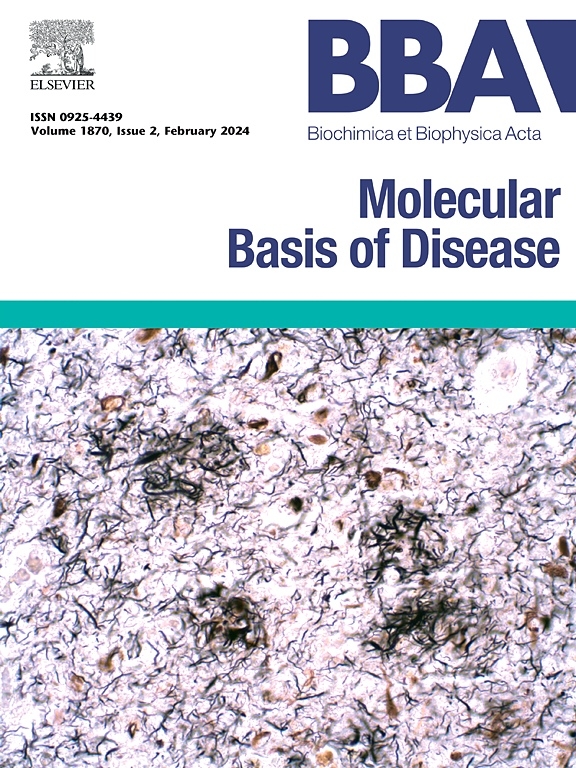Mission cholesterol: Uncovering its hidden role in ALS neurodegeneration
IF 4.2
2区 生物学
Q2 BIOCHEMISTRY & MOLECULAR BIOLOGY
Biochimica et biophysica acta. Molecular basis of disease
Pub Date : 2025-08-19
DOI:10.1016/j.bbadis.2025.168021
引用次数: 0
Abstract
Cholesterol is a central determinant of membrane architecture, signaling, and cellular homeostasis in the central nervous system (CNS). While historically viewed as a structural component, emerging evidence highlights its dynamic regulatory role in neuronal function, particularly through its compartmentalized synthesis, trafficking, and turnover. This review examines the complex landscape of cholesterol metabolism in the CNS, emphasizing the cooperative roles of astrocytes and neurons, the partitioning of biosynthetic pathways, and the barriers that distinguish brain cholesterol pools from peripheral sources. We focus on mitochondria-associated endoplasmic reticulum membranes (MAMs) as key regulatory platforms for cholesterol sensing, esterification, and signaling, underscoring their emerging role in neurodegenerative diseases. Disruptions in MAM integrity, lipid raft composition, and transcriptional regulation of cholesterol-handling genes have been linked to pathologies such as amyotrophic lateral sclerosis (ALS), particularly through the actions of TDP-43. By consolidating recent findings from lipidomics, cell biology, and disease models, we propose that cholesterol dyshomeostasis constitutes a shared mechanistic axis across diverse neurodegenerative conditions. Understanding this axis offers novel insights into the metabolic vulnerability of neurons and highlights cholesterol metabolism as a promising target for therapeutic intervention.
使命胆固醇:揭示其在肌萎缩侧索硬化症神经退行性变中的隐藏作用
胆固醇是中枢神经系统(CNS)膜结构、信号传导和细胞稳态的中心决定因素。虽然历史上被视为结构成分,但新出现的证据强调了其在神经元功能中的动态调节作用,特别是通过其分区合成、贩运和周转。本文综述了中枢神经系统胆固醇代谢的复杂图景,强调星形胶质细胞和神经元的合作作用,生物合成途径的划分,以及区分脑胆固醇池和外周来源的屏障。我们关注线粒体相关内质网膜(MAMs)作为胆固醇感知、酯化和信号传导的关键调节平台,强调它们在神经退行性疾病中的新作用。MAM完整性、脂质筏组成和胆固醇处理基因转录调控的破坏与肌萎缩性侧索硬化症(ALS)等疾病有关,特别是通过TDP-43的作用。通过整合最近来自脂质组学、细胞生物学和疾病模型的发现,我们提出胆固醇失衡在不同的神经退行性疾病中构成了一个共享的机制轴。了解这一轴提供了对神经元代谢脆弱性的新见解,并强调胆固醇代谢是治疗干预的一个有希望的目标。
本文章由计算机程序翻译,如有差异,请以英文原文为准。
求助全文
约1分钟内获得全文
求助全文
来源期刊
CiteScore
12.30
自引率
0.00%
发文量
218
审稿时长
32 days
期刊介绍:
BBA Molecular Basis of Disease addresses the biochemistry and molecular genetics of disease processes and models of human disease. This journal covers aspects of aging, cancer, metabolic-, neurological-, and immunological-based disease. Manuscripts focused on using animal models to elucidate biochemical and mechanistic insight in each of these conditions, are particularly encouraged. Manuscripts should emphasize the underlying mechanisms of disease pathways and provide novel contributions to the understanding and/or treatment of these disorders. Highly descriptive and method development submissions may be declined without full review. The submission of uninvited reviews to BBA - Molecular Basis of Disease is strongly discouraged, and any such uninvited review should be accompanied by a coverletter outlining the compelling reasons why the review should be considered.

 求助内容:
求助内容: 应助结果提醒方式:
应助结果提醒方式:


